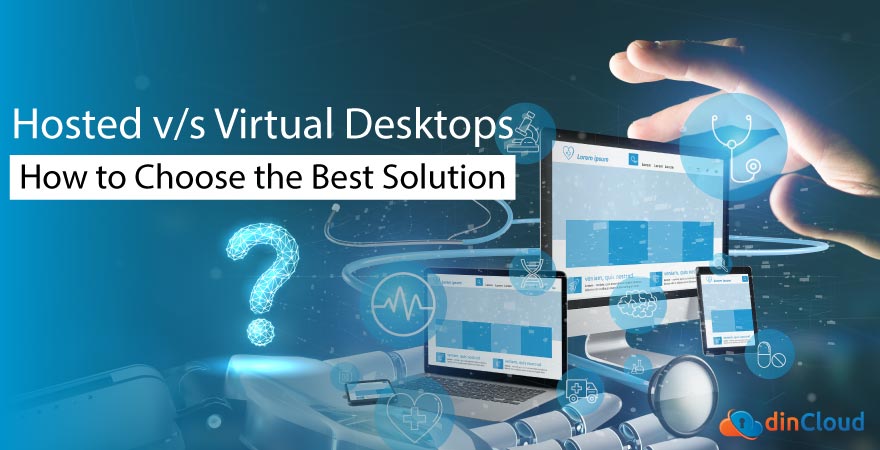The business landscape is evolving very quickly over the past few years. Companies are coming under increasing pressure to up their digital game and provide flexible productivity platforms that are not only secure, but accessible outside the workplace.

While this may seem asking for too much, modern information and communication technologies are actually making this happen. Slowly but surely, we are moving in the era where productivity will no longer be confined to organizational boundaries.
Also Read: What makes the Cloud a Resilient Technology Platform?
How has Virtualization Changed the Tech Landscape?
Revolutionary technologies such as virtualization are rapidly changing the entire landscape. The concept of desktop virtualization has paved the way for productivity platforms that are secure, flexible and remotely accessible from anywhere.
How does this affect organizational productivity? Well, the answer is certainly in the positive as the modern workforce can now access their tools and data virtually from anywhere, without having to worry about security.
Also Read: The Ultimate Cloud Coalition
Desktop Virtualization Types
In broad terms, when we talk of desktop virtualization, there are two main technologies or implementation models. Before we discuss each and the pros n cons, let’s briefly discuss virtualization of desktop computers.
Virtual Desktop / Virtual Machine (VM)
A virtual desktop, more often referred to as a Virtual Machine or VM, does not exist in physical form. Instead, it is created over a server by using complex virtualization technologies. A VM will also have performance specs such as storage, RAM and CPU etc.
To create VMs, very powerful and large servers are segmented with the help of specialized software into multiple personal computers. These VMs are then “streamed” over dedicated organizational networks or the internet to multiple end users.
Also Read: Post Pandemic Priorities for Cyber Security
Persistent v/s Non Persistent VMs
While we are discussing Virtual Desktops, its helpful if we also discuss the two main types of VMs as well. A persistent VM, as the name suggests, will retain the unique preferences of each end user till the next login or remote session.
So, persistent VMs tend to deliver a much superior and efficient end user experience (UX). However, they are more resource intensive as the additional preferences of each end user need to be stored for retrieval upon the next virtual session.
Non persistent VMs are the exact opposite of the above type. These VMs return to their original state as soon as the user logs out from a virtual session. Any unique preferences of the user are retained only for the duration of that particular session.
Although non-persistent VMs deliver a relatively compromised user experience, they are low on consumption of resources. Another plus point is that you can assign a “pool” of VMs to a group of users, without having to worry about their individual preferences.
Also Read: Mitigate your Ransomware Risk with Cloud Backup and Business Continuity
Hosted Desktops – DaaS
These virtual desktops are also called Cloud Hosted Virtual Desktops and Desktop as a Service (DaaS). In this deployment model of VMs, you source the virtual desktops from a specialized third party service provider (CSP) like dinCloud.
Under the DaaS model, all the underlying hardware resources belong to your Cloud Service Provider (CSP) such as dinCloud. These VMs are streamed over the internet and the sessions are secured using end to end encryption.
Hosted desktops eliminate the need for maintaining costly and complex on premise IT infrastructure such as servers, routers and gateways. In case of a DaaS model, your data needs to be migrated to the highly secure data centers of your cloud provider.
Also Read: How to be Productive “On the Go” with dinHVDs!
Virtual Desktops – VDI
Virtual Desktops, often called Virtual Desktop Infrastructure (VDI) are the other main deployment model for VMs. In a VDI model, you have to setup an on premise server or data center, over which the VMs will be provisioned.
In this model, the access to virtual machines is mostly restricted to the organizational boundaries. Still, this desktop virtualization model ensures all your organizational data is converged at a central point.
A VDI model is costly and complex to setup. It also carries an upfront hardware cost. Then, you have to maintain the underlying hardware resources yourself. The only major advantage of this model is that you maintain full control over your data.
Also Read: Why Should Cloud Security Evaluation be Your Top Priority?
Hosted Desktops or Virtual Desktops?
Well, there is no universal answer to this question. Each deployment model for virtual desktops has its pros and cons, which we will cover in detail in another post soon. We think Hosted Desktops or DaaS are a better solution as compared to Virtual Desktops or VDI.
As the cyber security of leading Cloud Service Providers (CSP) like dinCloud constantly improves, the notion of enhanced data security is almost neutralized for VDI. Additionally, a DaaS model is much more affordable and instantly scalable.
Also Read: How to Leverage the Cloud to Accelerate IT Initiatives?
If you are also in the search for a desktop virtualization platform, then DaaS is the more appropriate model. dinCloud offers a wide range of DaaS solutions that are suited for multiple use cases.
Contact Us for any further queries you may have about our Leading DaaS Solutions and one of our cloud experts will get in touch with you soon.


